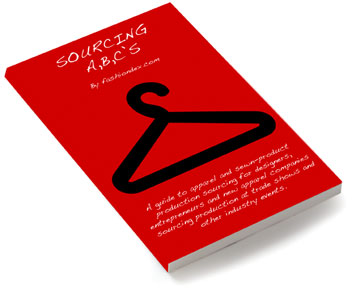
To find the fabrics, you first need to shop the fabric market. There are many fabric companies and salespersons who exhibit at sourcing and trade shows that you can meet. You can visit and source at fabric shows, or use our directory: The Small Designer’s Guide to Wholesale Fabrics to find your fabric. That directory works well for new brands as it lists low-minimum suppliers. The low-minimum fabric houses are called jobbers and wholesalers. You should avoid going directly to a mill at first, as you will not likely be able to meet their specified order quantity minimums at first. So shop the fabric market, see what you like, and ask for swatches. Approximately one-third of the fabric suppliers will be happy to provide you with swatches at no charge, and the other two-thirds will require you to pay for them. You can also order sample yardage from these fabric suppliers and make up the samples in the fabric you like, so they can see your garment concept in the correct fabrication. If you do not know what the type of fabric you want is called, then buy a garment at retail cut in the same type of fabric that you like, and go ahead and show that garment to a fabric supplier or to an apparel factory. Let them know that the garment is for fabric type only.
In terms of treatments, the same applies. If you desire a special dyeing technique or a unique type of printing, shirring, quilting, or embellishment, you will need to have an example of this particular treatment as well. With an example of the dyeing or finishing you like, a factory can advise if they have the needed dyeing/printing/quilting machinery required to produce your product.
Then there are trimmings. Trims include buttons, beads, braids, sequins, and other items that are attached to the garment. Trims are decorative and notions are functional. An example of a notion (also known as a finding) is a should pad or a collar stay. Trimmings and notions for your garments also need to be sourced and purchased. These are an additional cost and may require special machinery. Therefore, make sure you let factories know if you have any special trims in mind. Bring examples of any specialty trims you plan to use on your new product/garment line.
Many factories are capable of sourcing and providing fabric and the trimmings for you, so do bring swatches of fabric, trims, and treatments you have in mind- especially if they are unique. The fabric, embellishments, and type of garment you desire determines which factories can work with you, as different factories have different areas of expertise.